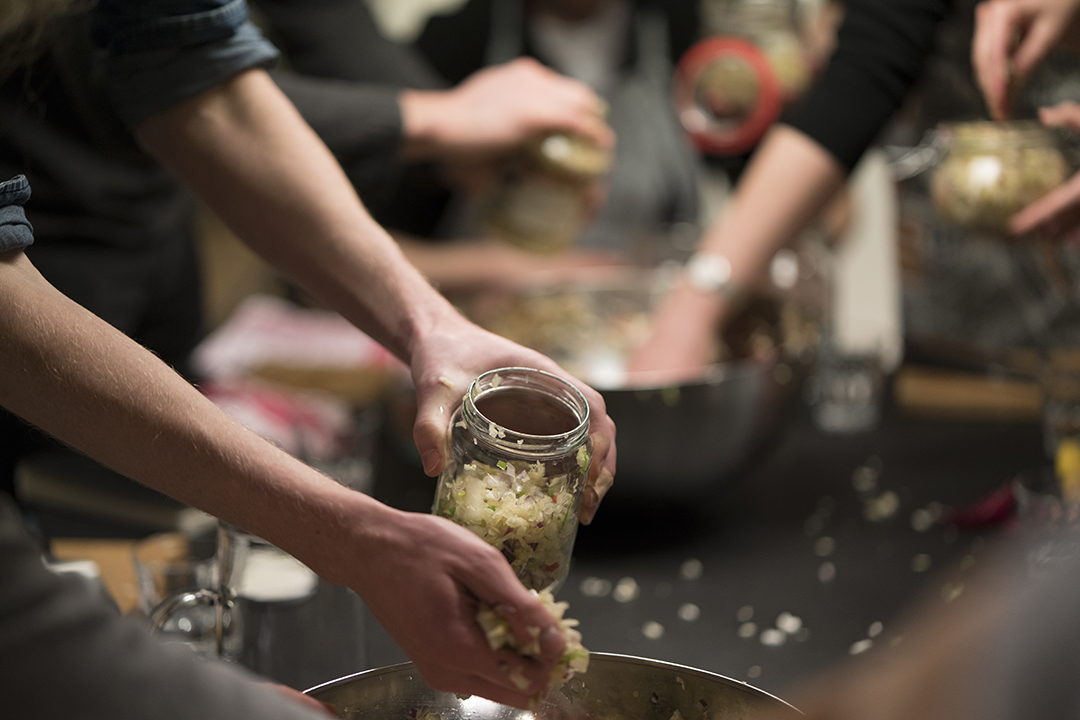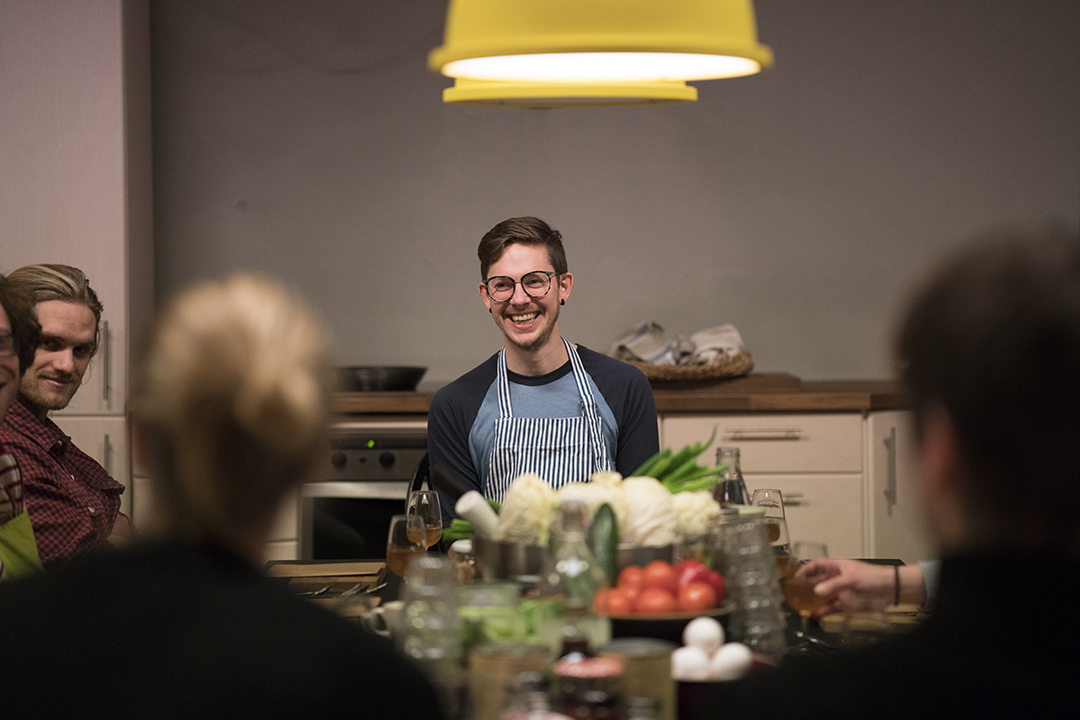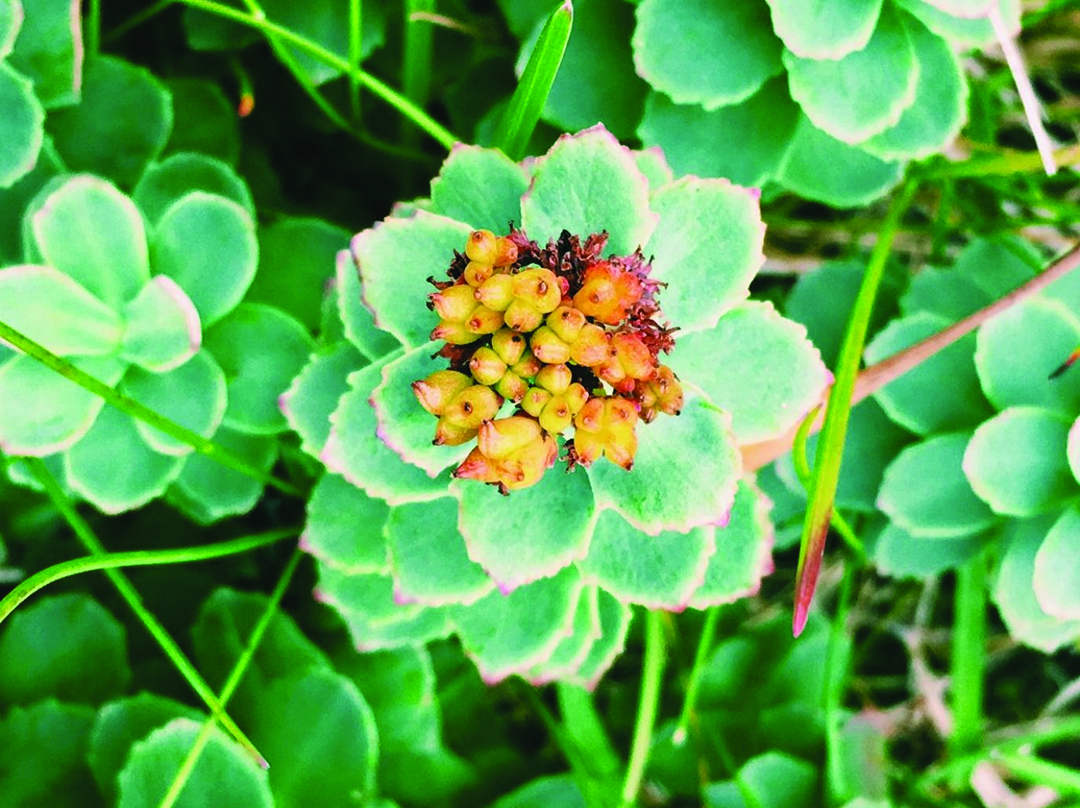Column
Forgotten Traditions
— Of Food
I wasn’t even really watching anything. I was dulling an already almost unbearably boring way to live.
You could say it was infuriating, really, but I couldn’t work up enough energy to be angry.
My batteries were all but spent. Lifting an arm felt heavy. Walking the stairs felt oh-so draining. Taking a shift at the bar where I worked seemed nearly unthinkable. Did someone say burnt out?
Four years later, I still work part-time at the bar, only this time with a healthy smile and a bounce in my step. I still watch Netflix, but I also read books with intensity, swim in the sea all year-round, dance with my friends and tend to my community backyard chickens. I find I am truly happy.
I also work with music, theatre and writing. And more relevant for us, I give classes and workshops in what I call the Forgotten Traditions of Food.
How did I pull that body off the couch, and out of the miserable semi-comatosis, into a balanced, yet energetic life filled with joy?
I laugh a little while writing this, realising I sound like someone selling her “secret´s out!” fresh-off-the-shelf self-help book, but that’s not it, I swear.
I simply want to tell my story, because I know there are more like me out there. In fact, it seems to me that most of the people genuinely interested in fermenting vegetables, making broth or baking with sourdough, are people who have experienced various undiagnosable health issues.
Many have come to the realization that their bodies need more than white bread, margarine, diet soda and pre-prepared meals.
Of course I dragged my sack of bones and blood to the doctor—several doctors, in fact. “Please fix me, Sir or Ma’am”. But alas, no physician that I met on this mission could ever figure out what was wrong. All the tests I took would only show perfectly normal levels of vitamins and minerals, histamines, electrolytes, blood cells of different kinds, blood pressure, blood sugar, blood blah blah blah.
I felt that the only thing I could do in the end was to try anything and everything other than conventional medicine. So that I did.
I’ve fasted for days. I’ve tried LCHF (low carb, high fat). I tried taking out dairy, grains, legumes, caffeine and alcohol from my diet. I spent a month’s salary on acupuncture, and the same amount again on a foot zone therapist. I even went to see a healer who gave me a message of love from my aborted big sister (!).
None of the above had any sufficient, long lasting effect. What actually helped me, though, was changing what I ate, and more importantly how I prepared it.
With an abundance of rest and some homemade herbal remedies, I nursed myself back into a living person in place of that exhausted zombie.
I’m not going to lie. I still have issues. For example, I have a ridiculously persistent allergy towards house mites. Whatever I do I cannot seem to get rid of it. Though I’m much better now than earlier, and, with some medication, I’m almost symptom-free. (So, yes, thank you conventional medicine; I won’t disregard you altogether.)
I bet you’re furrowing your brow and biting your lip in anticipation. What did I do? I will tell you all in due time. Firstly I found some new friends. I can see them all sitting on my bookshelf in front of me in my little kitchen writing nook.
“Their names?,” you prompt me. Very well. Be prepared; pencils poised… Norwegian fermentation specialist and food traditionalist Gry Hammer, her North American equivalent Sally Fallon, International Fermentation Guru Sandor Katz, and my hippie aunt Rosemary Gladstar, acclaimed herbalist and healer.
I’ve had many an interesting, lengthy (albeit imaginary) conversation with Rosemary, Sandor, Gry and Sally. They’ve taught me most of what I know from each of their fields of expertise.
So, I started experimenting with Sandor’s fermented vegetables, Sally’s bone broth, Gry’s soaked grains and Rosemary’s herbal medicine, reading, doing and learning as I went.
Several years later I still make all of that and more. There is always some kind of living thing bubbling away on my kitchen counter. My beloved Suri Sourdough is looked after following her rigorous feeding regime. Family and friends give me bags of bones left over from various dinners for me to brothify, and oils and tinctures stand steeping in my window sills during summer.
So then, I guess you’d like for me to share with you some of my experiences regarding healing foods and natural medicine? Here we go!
My top three life changing foods/medicines:
Kimchi
When I started my adventure, there was little information, and absolutely no way to find out if what I made tasted correct. In fact, I threw out what I later realised must have been a perfectly fine kimchi, thinking that no one could ever be persuaded to consume this weird, odorous jar-dweller.
Kimchi has later become one of my absolute favourites, due to its versatility and deliciousness. I use it with almost all kinds of dishes, on cheese, in salads, with scrambled eggs – you name it.
Kimchi also seems to settle my stomach like no other ferment, so I find myself holding a kimchi jar and a fork every now and again—and even also later on.
When we make kimchi, like other fermented foods or beverages, the primary goal is (or at least used to be) to preserve the food. But, as a wondrous and peculiar parallel miracle, we also make something that both feed and replenish our microbiota.
In and on our bodies, we host a stunning amount and variety of microorganisms. Some are just there, but many help us in different ways. In our gut we have about a kilogram of live bacteria, from a wide array of families, that digest foodstuffs that we don’t assimilate in our small intestines. Our whole colon is a fermentation chamber and, curiously, a lot of hormonal regulation starts here, with our little friends.
And that, my dears, is why I make and eat kimchi. In the jar of fresh vegetables, we facilitate the rise of a civilisation of lactobacillus that we can ladle into our bodies by the spoonful. An army of good soldiers to fight for our well-being. And kimchi has a lot of those soldiers, the so-called probiotics, along with ample amounts of probiotic soldiers’ favourite food, confusingly called prebiotics. Overwhelming? I know. But also nerdy fun-fun, when (or if) the interest blossoms.
But ah! Kimchi! To me, it is as much a medicine as it is a regular condiment. I’ve made and eaten many different jars, and here I present a basic recipe I’ve used many times. (Drumroll…)
Recipe:
Put one cleaved head of crispy fresh napa cabbage in a cooled salty brine (8 tbsp salt for 2 litres of water). Leave for eight hours at room temperature.
Rinse the cabbage in fresh water, and chop or tear into pieces. Imagine…you’ll want the perfect size to insert into a waiting, excited and hungry human mouth (namely yours). Mmmm-hm!
Mix with other rinsed and chopped vegetables, for example:
1 carrot
4 radishes
4 spring onion
½ red onion
chili, garlic and ginger to taste
In a large bowl, massage the ingredients until you can squeeze a fair amount of moisture from a handful of kimchi. It should be wet, not merely damp. I’m talking dripping squeezing hands here, all right?
With this wet and mouthwatering mix you’ll create the pungent, complex taste of kimchi through the almost alchemical process of fermentation!
The top tip of successful fermentation is to eliminate oxygen from the process. Stuff the mix into jars, and stuff the stuff hard! You want the aforementioned wetness to overflow the veggies, covering all the bits.
If you have a little something to cover the ferment with, to push it down under the surface of the juices, use it! I use lids from smaller jars, pillows made from plastic bread bags with water in them, boiled river stones or cabbage leaves with a smaller jar stuck on top, pressing down inside the fermentation vessel. You could also visit the ferment in the days to come and push the contents under the surface with a fork or a spoon a couple of times a day. The point is to avoid the pesky molds finding a nesting place for their next village.
What’s fun about kimchi is how many ways it can be tweaked and adapted. The recipe you just read can be used as a starting point, but I urge you to experiment. You’ll find a myriad of recipes out there, but I truly super duper recommend finding the Korean Chef Maangchi and her delish traditional fresh red kimchi, called Tongbeachu Kimchi. Mmmmm… bodies rejoice!
Tincture of Roseroot
Food and medicine have not always held clearly defined boundaries. Some foods are highly medicinal, and some medicines serve as food, as well. Some of the active substances you find in medicinal plants will be in regular foods, but the amount varies.
One of the most potent and magical medicinal plants of Scandinavia is called Roseroot, or Rhodiola Rosea in Latin.
Four years back, I was on the west coast of Norway over the summer, when I read about the plant and its properties in a book that my mother-in-law had brought. I read that this plant is an adaptogen.
Adaptogens are medicinal plants whose effect on the human body is such that it heals where the hurt is, meaning it works on what ails you.
You could also say that they work as normalizers of normal bodily functions. Other adaptogens you may have heard of are ginseng roots and reishi mushrooms.
Roseroot is said to have a whole array of positive effects on the body, but most importantly it is said to raise your energy levels. This was very interesting to me, and seeing as the plant is endemic in the area around my partner’s family cabin, I went out to gather, rinse, chop and steep Roseroot rhizomes in vodka.
After five weeks in a jar, I took out the spent pieces of Roseroot and strained the now deep red vodka through a cloth. I started taking the appropriate dosage right away and felt the effect after only a few days. My flat batteries were recharging!
Soon I could visit friends or go to dinners and parties without planning for one or two of my many power naps, I could walk up the three floors to our apartment without feeling the well-known powerlessness in the muscles in my legs. I could wake up and greet the day in earnest!
I have pushed this remedy on several of my tired friends, but none have had the miraculous change that I experienced. I don’t fret. It worked its magic on me and it might very well do the same for you. If you want to make the tincture yourself, this is how you do it.
Recipe:
Place scrubbed, chopped (not peeled) Roseroot roots in a jar and cover with 40-60% alcohol.
Place the jar in your windowsill for four to six weeks. Shake the jar vigorously every day.
Strain out the pieces and put the tincture in a bottle.
Start with a teaspoon a day. Increase up to a tablespoon a day until you have a good effect.
With herbal medicine, it is smart to take a break from the use of a remedy for half the amount of time you’ve taken it. For example, having taken Roseroot tincture for two weeks, stop taking it for one, before starting with the medicine again. This is to avoid letting the body “get used to” the active substances and which could result in the loss of the effect.
You can do four days on, two days off, or you can do four months on, two months off—your choice.
And be patient. If you don’t feel any change after a week, up the dosage and continue. It might take a little time before your body reacts.
There are not many reports of side effects using Roseroot, but as with any medicine, you should stop taking it immediately if you do no not feel well after ingestion.
Sourdough
My third change was switching from yeast to sourdough when baking my breads. For years, I had a veritable gas production plant in my stomach every time I tried eating unfermented grains, be it pasta, rice, oatmeal, cinnamon buns or bread from the store. You see, these plants have developed antinutrients to make themselves unpopular amongst herbivores. Antinutrients that lock up the different nutrients can be really hard to digest. Those antinutrients are what made my belly inflate.
And then I learned that a sour environment (sourdough, vinegar, lemon juice) will neutralize the antinutrients in grains? Similar use: salty water for seeds and nuts and just fresh water for legumes. These foodstuffs have these built-in protections against being eaten, which makes them less easily digestible or even straining to your intestines when consumed unsoaked. When left in water, salty water, or a mild acid, they will readily give up their nutrients for our bodies’ benefit.
So, back to the breads. I will admit I had to try once, twice, thrice and more before actually producing edible baked goods with sourdough.
My husband, bless his heart, is a notoriously positive omnivore, always stating that what I make is delicious, but I know he must have been lying hard in those early days of sourdough.
After many compact and unpalatably sour loaves, I found the way to make good breads, and I also started fermenting my porridge and cereal with the selfsame sourdough, my sweet (sour) Suri. The results? Belly very happy and as well as my organism. As stated, I make a variety of foods with Suri, but the recipe that follows is my go-to easy-bake everyday staple.
Recipe:
Easy Suri-loaves
2 kg flour (apx. 70/30% wholemeal/sifted, with different kinds of grain)
1,5 litres cold water
30 g salt
100 g active sourdough
Mix everything well and pour into three bread pans (greased and with a strip of baking paper covering the bottom for easy extraction. The dough is quite wet.)
Put the pans in your cold oven with a bowl of boiling water for moisture. Leave for 6-12 hours depending on the room temperature.
In the summer it takes six hours, but in the winter the breads may ferment for ten hours without being ready. If it is really cold, I usually start the oven on the lowest setting for 3-5 minutes, towards the end. In a lukewarm oven the final rise goes quickly.
Take the breads out and heat your oven to 200 degrees Celsius. Bake for an hour. Knock on the top of the breads, to know when they’re done. They’ll be done when they have a hollow sound.
I use regular 1,5 litre bread pans, and I bake them when the dough reaches the edge.
It is very important to use an active sourdough when baking. It should be bubbly and smelling tangy. As a smart little test, the starter should float when in water. Put a teaspoon of the starter in a cup of H2O and check its liveliness. Is it floating? Boom! Ready!
Together with these three, for me, life changing foods and medicines, I do other things. I take cod liver oil the whole year through. I eat local honey, drink fermented beverages such as kombucha, water kefir and milk kefir along with other fermented dairy products. And I think nutrient dense regarding what I choose to consume.
You may have heard the expression overfed and malnourished? It’s what happens when you eat high calorie but nutrient scarce foods, such as sugar, white bread, refined foods and pre-prepared meals where taste has been pressure-cooked to death and then boosted with taste enhancers such as sugar, salt and MSG. Na-ah. No, thanks.
I eat cheese, butter and meat from animals that have been treated with respect, or have lived their life in the wild. Veggies and leafy greens and backyard chicken (or eco) eggs. Bone broth, some seeds and nuts that I soak or sprout. And of course some more unhealthy foodstuffs, such as chocolate, beer and potato chips.
All of the things that I prepare and ingest work together to bring a good balance. It took such a long time for me to find the changes necessary for a beneficial direction for my health.
My dream is that my classes and workshops and writing might help some of you who want the same changes to be inspired to try. I want you to try.
Start small. Try one thing first. Hell, I tried a hundred things first, and I discarded most of them. And that’s the idea here, that you don’t have to.
Along with the health benefits, I have found that this wholesome and real food is so, so tasty! I will never go back to powdered soups and sauces, frozen pizzas or white store bought light as air bread, no.
Give me a cup of chicken broth with parsley, a slice of sourdough bread with scrambled eggs and kimchi, a glass of kombucha with a spoonful of tincture, and I know I’ll be strong and happy meeting the world!
If you want to learn more, visit the website bardwatn.no or e-mail me for information on my classes. There are also several groups on Facebook. Search for traditional food, fermentation, broth, sourdough and/or natural medicine.
Good luck and bon apetít!
This is an article from Hauste Magazine.
Words by Bård Watn.
Photographs by Alexander Benjaminsen, Caroline Hargreaves and Food Studio.



